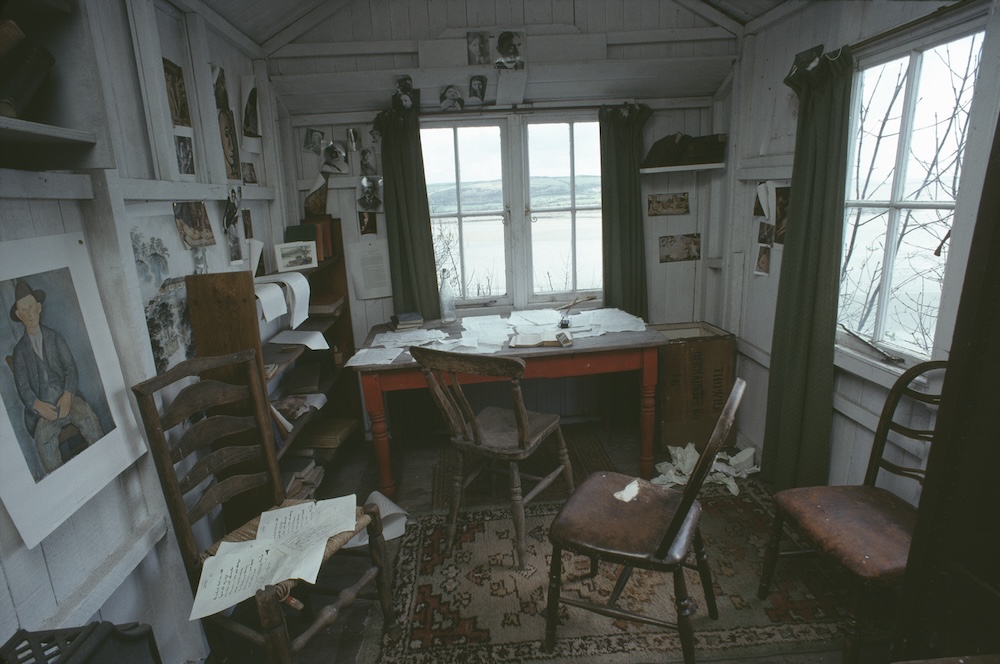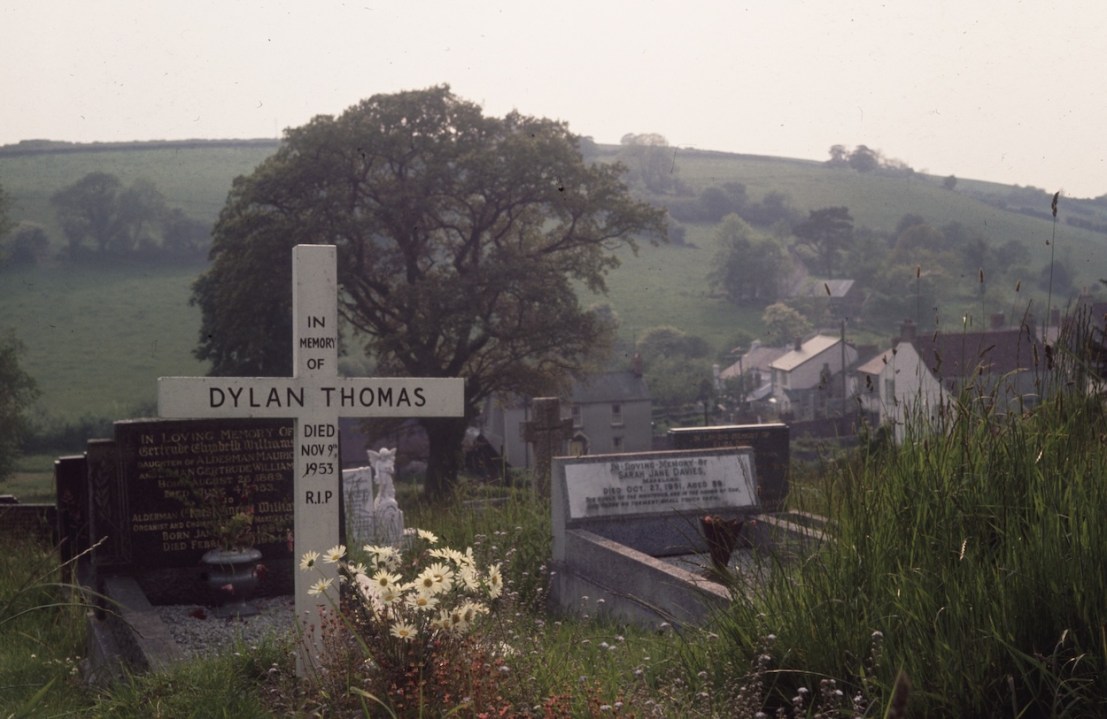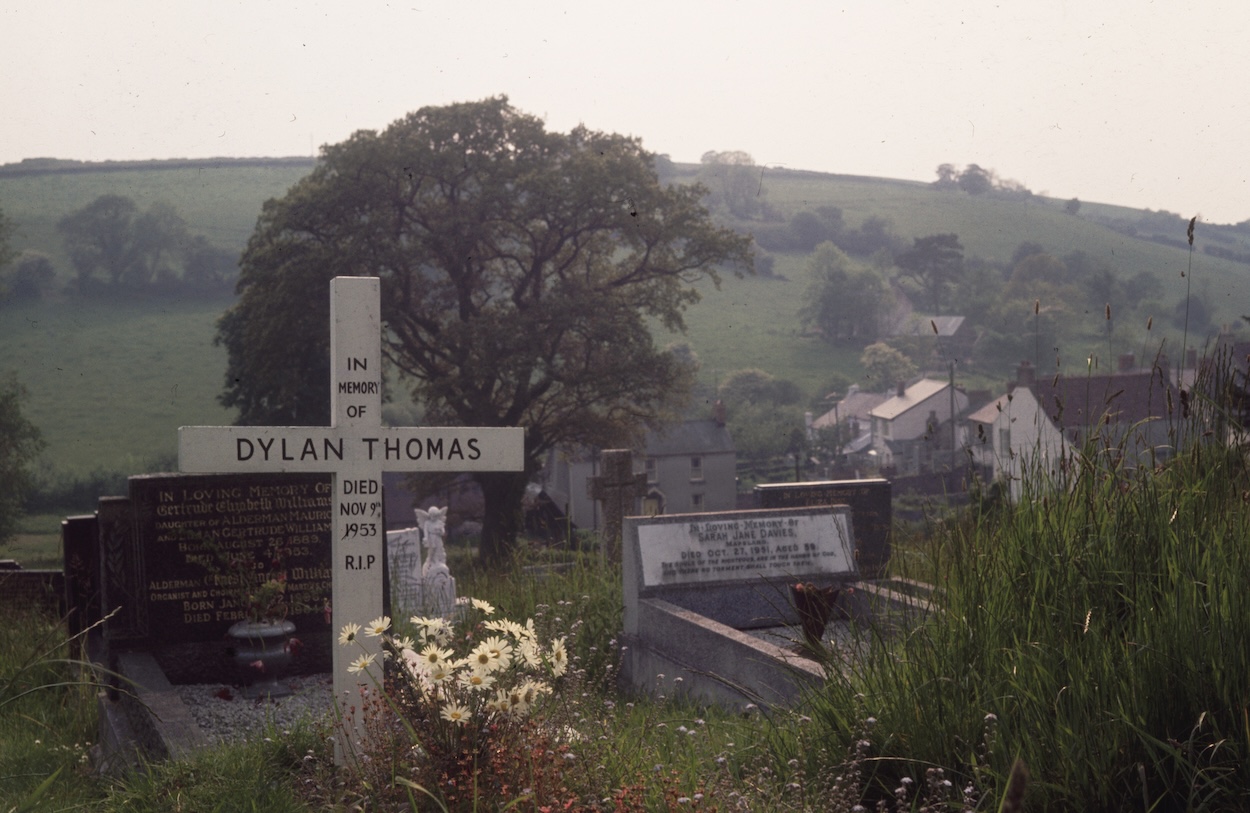Almost anywhere you go in Cardigan Bay – that bite out of West Wales which runs a hundred miles along the Irish Sea – the spirit of Dylan Thomas seems to go with you. The Swansea-born poet may only have lived in Cardiganshire intermittently, fleeing the bohemian bedlam of Fitzrovia during the second world war, but the time he spent there produced some of his greatest poems – among them ‘The Conversation of Prayer’, ‘A Refusal to Mourn the Death, by Fire, of a Child in London’, and the beginnings of ‘Fern Hill’ – his ringing, singing recollection of a lost and longed-for childhood.
‘Much of Thomas’s real work was done on high ground, looking down on things,’ wrote biographer Paul Ferris, ‘usually the sea, usually in Wales,’ and Thomas’s wife Caitlin agreed. He wrote here, she said, ‘with a sort of driving, pent-up energy,’ poems which had ‘a serenity… I could hear the noise they made, which was for me a kind of music.’
It is New Quay that Thomas is most closely linked with, a fishing town sloping high on wooded hills above Cardigan Bay, where he lived for just nine months. New Quay is pretty: its rising tiers of bow-fronted houses are painted white, cobalt blue, Nesquik pink, with names like ‘Glan-y-Don’, ‘Gwynfryn’ and ‘Brynheulog’. Some of them have old model ships – often bottled – in the windows.
Alongside the beach, a seemingly endless ribbon of sand around Thomas’s ‘fishing boat bobbing sea’, there’s a hulking stone jetty on which crowds sometimes gather to watch the bay’s bottlenosed dolphins when they swim into harbour. The October sky glints off the greenish sea which at duller moments – as disapproving clouds cluster grimly overhead – looks grey, sinister and dormant. Far away across the water are the mountains of Snowdonia, standing out snow-peaked and protective on crisp winter days. ‘Aesthetically the great merit of the Welsh sea,’ said long-time Wales resident Jan Morris, ‘is that land generally shows across it.’
The town, now sustained by tourism and sea-life-spotting boat trips, used to churn out master mariners – sailors licensed to captain ships, especially in the merchant navy – and local cemeteries are awash with those who died at sea. Overlooking the bay, on a little patch of greensward, is the statue of a young girl blowing kisses to the horizon: a reminder, says the guidebook, ‘of the longing of New Quay families for the mariners who spent months, sometimes years, away’ from them.
Here Thomas and his family lived in a rented white wood-and-asbestos shack called ‘Majoda’, perched on the clifftop, heated by paraffin and lit by gas. Rent was £1 a week, but on payment days Thomas would reputedly skulk in the outdoor lavatory, hiding from his landlord, who found him congenial but recognised a rascal too. Thomas’s wife Caitlin, fiery and volatile as a swan, drank at a bar called the Dolau Inn (now a rooming house), while Dylan preferred the Black Lion, a low-ceilinged, stone-walled pub (still doing brisk trade) from which he used to bring back flagons of beer in his baby’s pram. (‘To drink moderately, we were… convinced was definitely beneath us,’ Caitlin wrote, ironically, later on. ‘Only miserable, frightened little people did that.’)
But what makes New Quay so interesting is that, along with Laugharne in Carmarthenshire, it was the model for the fictional town of Llareggub (try reading it backwards) in Under Milk Wood, Thomas’s exuberant radio play about the inhabitants of a Welsh fishing town and their macabre, often yearning inner lives. Plaques to the poet are everywhere in New Quay, marking out the ‘Dylan Thomas Trail’ which runs for more than 20 miles along the coast. A book of the same name, by Dylan expert David N. Thomas, is helpful in teasing out the links.

A retired master mariner known as Tom Polly, who Dylan drank with at the Black Lion, may well have been the prototype for Milk Wood’s Captain Cat, dreaming in afternoon naps, as the tears snuffle from his eyes, of dead Rosie Probert, ‘the one love of his sea-life that was sardined with women’. New Quay’s Memorial Hall, its lists of war dead a teeming roster of Joneses and Evanses, is the model for Milk Wood’s Welfare Hall, where local scrubber Polly Garter swabs the floors, singing of her past romantic skirmishes: ‘And I’ll never have such lo-ov-ing again!’ There were New Quay precedents too for postman Willy Nilly – who opens the letters and broadcasts them to the town – and Mrs Ogmore-Pritchard, the widow whose domestic hygiene goes off the scale of obsessive-compulsive disorder (‘And before you let the sun in, mind it wipes its shoes!’). The parallels between art and life, mapped out by those Thomas plaques, go on and on.
You pass Thomas’s ‘Majoda’ (shack replaced, name intact) on the coastal path out of the town, which takes you up and down cliffs, over wooden bridges, past teeming blackberry bushes and fat, dangling rosehips to the neighbouring settlement of Aberaeron. Aberaeron makes a bracing contrast with New Quay – as flat and geometric as New Quay is higgledy-piggledy, and with a slightly melancholy, unfinished atmosphere that isn’t accidental.
‘Much of Thomas’s real work was done on high ground, looking down on things’
The town was planned meticulously in the 19th century as a luxury seaport, its founding father, the Revd Alban Thomas Jones Gwynne, not only specifying the layout of the streets and the colour of the houses, but that they should be repainted biannually. Yet the wilting shipping trade and a lack of good beaches put paid to it, and these days, as Thomas said of his fictional town, ‘you can hear the dew falling, and the hushed town breathing.’
All the better for it, some might say, and I can’t decide which place I prefer. In winter, I’m told, New Quay’s holiday homes shiver untenanted, while Aberaeron’s residents stay put. Certainly it feels more authentically Welsh, at least as Kingsley Amis, who lived in Swansea for more than a decade, defined it: ‘An extra greenness in the grass, a softness in the light, something that was very like England and yet not England at all, more a matter of feeling than seeing but not just feeling, something run down and sad but simpler and freer than England all the same.’
Aberaeron feels, at any rate, informal and approachable. Into its high-walled harbour, where the masts of old sea boats click and chink in the wind, the river Aeron trickles mossily out of the woods beyond. Thomas’s ‘heckling’ seagulls strut along the promenade, making their evening hullabaloo (‘Gulls just want to have fun,’ says a local car sticker). There’s an old working chapel on Tabernacle Street, a nearby baker’s called Y Popty (‘the oven’) and at Market Street’s Manchester House (now a ‘luxury outfitters’), the original shop sign is still picked out in large white, antique letters: J. ROBERTS, DRAPER.
Here again are echoes of Thomas’s Llareggub; J. Roberts, whoever he was, brings to mind Milk Wood’s Mog Edwards, the besotted fabric salesman who writes to Myfanwy Price, his intended, the most rapturous words he can think of: ‘I love you more than all the flannelette and calico, candlewick, dimity, crash and merino… muslin, poplin, ticking and twill in the whole Cloth Hall of the world!’








Comments